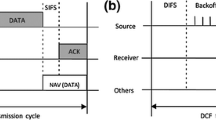Abstract
In wireless networks, it is well known that the interference of hidden nodes can interrupt frame receptions. Although several solutions have been proposed to alleviate the problem of DATA corruptions at receivers, control frame corruptions at transmitters have not been considered yet. In this paper, we propose an enhanced MAC protocol, called Robust and Cooperative Medium Access Control (RCMAC), to improve the network throughput and fairness by reducing control frame losses at transmitters. RCMAC uses a relay mechanism to allow transmitters of long distance links to receive control frames more robustly by relaying control frames via relay nodes. Furthermore, RCMAC improves the network throughput through fast two-hop DATA transmissions via relay nodes. Our extensive simulation results show that RCMAC has better performance than existing well-known MAC protocols.
Similar content being viewed by others
References
Bharghavan, V., Demers, A. J., Shenker, S., & Zhang, L. (1994, September). A media access protocol for wireless LANs. In Proceedings of ACM SIGCOMM.
Chen, Q., & Niu, Z. (2004, August). A delayed adaptive retransmission scheme for false route failure in MANET. In Proceedings of IEEE APCC.
Haas Z. J., Deng J. (2002) Dual busy tone multiple access (DBTMA)—a multiple access control scheme for ad hoc networks. IEEE Transactions on Communications 50(6): 975–985
Holland, G., Vaidya, N., & Bahl, P. (2001, July). A rate-adaptive MAC protocol for multi-hop wireless networks. In Proceedings of ACM MobiCom.
IEEE 802.11. Part 11: Wireless LAN Medium Access Control (MAC) and Physical Layer (PHY) Specifications. IEEE 802.11 Standard, Aug. 1999
IEEE 802.11a. Part 11: Wireless LAN Medium Access Control (MAC) and Physical Layer (PHY) Specifications: High-speed Physical Layer in the 5 GHz Band. Supplement to IEEE 802.11 Standard, Sep. 1999.
Jain R. (1991) The art of computer systems performance analysis: Techniques for experimental design, measurement, simulation and modeling. Wiley, London
Lai W. K., Tsai H. S., Li C., Shieh C. S. (2008) A power efficient solution to the large interference range problem in ad hoc networks. Wireless Communications and Mobile Computing 9(9): 1264–1273
Leng, S., Zhang, L., & Chen, Y. (2005, May). IEEE 802.11 MAC protocol enhanced by busy tones. In Proceedings of IEEE ICC.
Liu P., Tao Z., Narayanan S., Korakis T., Panwar S. S. (2007) CoopMAC: A cooperative MAC for wireless LANs. IEEE Journal on Selected Areas in Communications 25(2): 340–354
Lu, M. H., Steenkiste, P., & Chen, T. (2009, September). Design, implementation and evaluation of an efficient opportunistic retransmission protocol. In Proceedings of ACM MobiCom.
Perkins, C., Royer, E., & Das, S. (2003, July). Ad hoc on-demand distance vector (AODV) routing. IETF, RFC 3561.
Qiao D., Choi S., Shin K. G. (2007) Interference analysis and transmit power control in IEEE 802.11a/h wireless LANs. IEEE Transactions on Networking 15(5): 1007–1020
Rappaport T. (2001) Wireless communications: Principle and practice (2nd ed.). Prentice Hall, Englewood Cliffs
Shan, J. F., Chen, Z., Wang, H., & Yu, N. H. (2007, August). An effective MAC scheme based on large interference range in mobile ad hoc networks. Proceedings of machine learning and cybernetics.
The Network Simulator—ns-2. http://www.isi.edu/nsnam/ns/. February 10, 2005
Wu, C., & Li, V. O. K. (1987, August). Receiver-initiated busy-tone multiple accesses in packet radio networks. Proceedings of ACM SIGCOMM workshop on frontiers in computer communications technology.
Xu K., Gerla M., Bae S. (2003) Effectiveness of RTS/CTS handshake in IEEE 802.11 based ad hoc networks. Ad Hoc Networks Journal 1(1): 107–123
Yee, J., & Pezeshki-Esfahani, H. (2002, November). Understanding wireless lanperformance trade-offs. In Proceedings of communication systems design.
Yu C., Shin K. G., Song L. (2007) Maximizing communication concurrency via link-layer packet salvaging in mobile ad hoc networks. IEEE Transactions on Mobile Computing 6(4): 449–462
Zhu H., Coa G. (2006) rDCF: A Relay-enabled Medium Access Control Protocol for Wireless Ad Hoc Networks. IEEE Transactions on Mobile Computing 5(9): 1201–1214
Zorzi M., Rao R. (1994) Capture and retransmission control in mobile radio. IEEE Journal on Selected Areas in Communications 12(8): 1289–1298
Zou S.-H., Li B., Wu H.-T., Zhang Q., Zhu W.-W. (2006) A relay aided media access (RAMA) protocol in multi-rate wireless networks. IEEE Transactions on Vehicular Technology 55(9): 1657–1667
Author information
Authors and Affiliations
Corresponding author
Rights and permissions
About this article
Cite this article
Kim, DW., Lim, WS. & Suh, YJ. A Robust and Cooperative MAC Protocol for IEEE 802.11a Wireless Networks. Wireless Pers Commun 67, 689–705 (2012). https://doi.org/10.1007/s11277-011-0405-5
Published:
Issue Date:
DOI: https://doi.org/10.1007/s11277-011-0405-5




